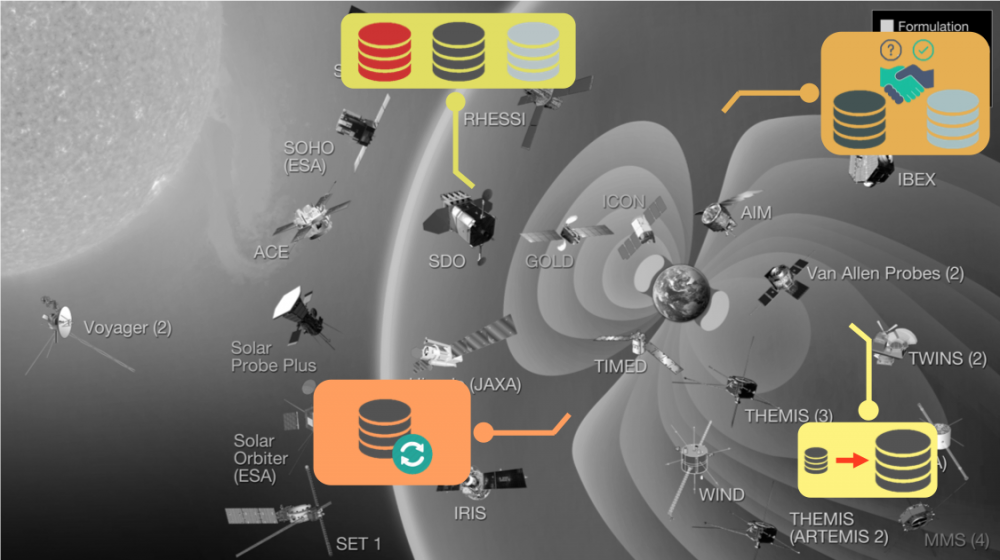Executive Summary
The magnetosphere, ionosphere and thermosphere (MIT) act as a coherently integrated system (geospace), driven in part by solar influences and characterized by variability and complexity. The manifestation of this variability and complexity is known as space weather, which refers to the effects of solar energy in geospace that threaten the technological infrastructure that powers the world [Schrijver et al., 2015]. Space weather events also known as “geomagnetic storms” can disrupt the operation of power grids, magnetic surveying and directional drilling for oil and gas. These storms also heat the ionosphere-thermosphere (~100-1000 km altitude), changing density and composition and disrupting radio communications and Global Navigation Satellite Systems (GNSS). Storm-driven charged particles and radiation throughout geospace are a hazard to the health of astronauts, passengers on high altitude flights and all space-based technologies.
Among the most important and yet uncertain aspects of the geospace system is energy and momentum coupling between regions, which is accomplished by electromagnetic fields, or Poynting flux, and the transfer of charged particles. Particles are transferred from the magnetosphere to the ionosphere in a process known as particle precipitation [e.g., Hardy et al., 1985], and particles of ionospheric origin undergo energization to escape to the magnetosphere [e.g., Strangeway et al., 2000]. Flow of particles in both directions are critical to the composition and dynamics of each region and are inherently multiscale processes. However, existing models do not capture the multiscale aspects, largely neither address nor quantify uncertainties, and are increasingly ill-equipped to provide the specification necessary for the growing demand for space weather forecasts. The extent to which shortcomings in existing models of particle precipitation and ion outflow impact our understanding of geospace and ability to predict space weather is unknown.
Due to recent trends in the availability of data, we now face an exciting opportunity to progress geospace understanding through the intersection of traditional approaches and state-of-the-art data-driven sciences [McGranaghan et al., 2017]. Data (from simulations and direct observations distributed throughout the solar wind and geospace system) are now available to take advantage of cutting-edge data-driven approaches, summarily referred to here as ‘machine learning’ (ML) techniques. Although Poynting flux can be quantified at large scales via global observations of ionospheric convection (e.g., from the Super Dual Auroral Radar Network, SuperDARN) and field-aligned currents (e.g., from the Active Magnetosphere and Planetary Electrodynamics Response Experiment, AMPERE) [Waters et al., 2004], comparable global observations of particle transfer are not available. We propose a workshop that will cut across disciplinary lines to better utilize particle transport data for the prediction of energy and momentum transfer in geospace by the ML techniques of uncertainty quantification and neural networks. The proposed work will produce a leap forward in the understanding of geospace particle transfer, both in the quantification of the uncertainties of current models (e.g., data products that quantify how unknowns in electron particle precipitation map to errors in ionospheric conductivity estimation on different scales) and by establishing a foundation for improved predictive models using neural networks.
Hardy, D. A., M. S. Gussenhoven, and E. Holeman (1985), A statistical model of auroral electron precipitation, J. Geophys. Res., 90(A5), 4229–4248, doi:10.1029/JA090iA05p04229.
McGranaghan, R. M., Bhatt, A., Matsuo, T., Mannucci, A. J., Semeter, J. L., & Datta-Barua, S. (2017). Ushering in a new frontier in geospace through data science. Journal of Geophysical Research: Space Physics, 122, 12,586–12,590. https://doi.org/10.1002/2017JA024835.
Schrijver, C.J., et al., Understanding space weather to shield society: A global road map for 2015–2025 commissioned by COSPAR and ILWS, Advances in Space Research, Volume 55, Issue 12, 2015, Pages 2745-2807, ISSN 0273-1177, https://doi.org/10.1016/j.asr.2015.03.023.
Strangeway, R. J., C. T. Russell, C. W. Carlson, J. P. McFadden, R. E. Ergun, M. Temerin, D. M. Klumpar, W. K. Peterson, and T. E. Moore (2000), Cusp field‐aligned currents and ion outflows, J. Geophys. Res., 105(A9), 21129–21141, doi:10.1029/2000JA900032.
Waters, C. L., Anderson, B. J., Greenwald, R. A., Barnes, R. J., and Ruohoniemi, J. M.: High-latitude poynting flux from combined Iridium and SuperDARN data, Ann. Geophys., 22, 2861-2875, https://doi.org/10.5194/angeo-22-2861-2004, 2004.
Science Questions
We propose to investigate the following questions:
- What are the quantitative uncertainties in (existing) particle precipitation and ion outflow models?
- To what extent do these uncertainties propagate to uncertainties in critical space weather parameters of the magnetosphere and ionosphere (e.g., magnetospheric composition and ionospheric conductivity)?
- To what extent can neural networks yield improved models of particle precipitation and ion outflow, and, ultimately, improve space weather forecasts?
